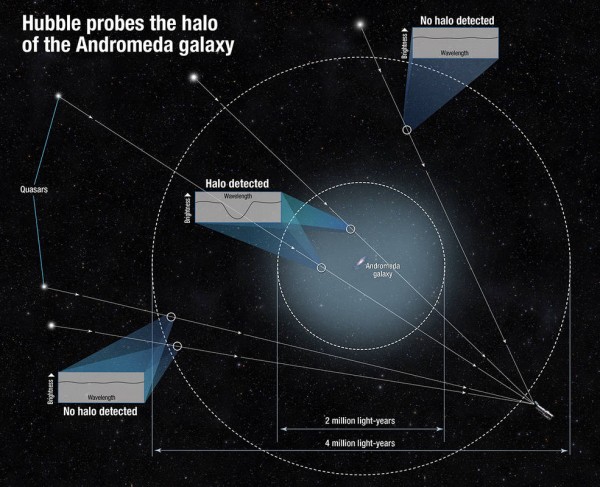Galaxies 'Waste' Heavy Elements That can Potentially Form Planets
| Ana Verayo | | Jun 07, 2016 07:22 AM EDT |
(Photo : NASA/STScI) The immense halo of gas enveloping the Andromeda galaxy, our nearest massive galactic neighbor, is about six times larger and 1,000 times more massive than previously measured.
Astronomers have identified how galaxies apparently "waste" a massive amount of heavy elements that are generated by their stellar nurseries as they emit these and reaching millions of light years away.
This new research by the University of Colorado Boulder reveals how more carbon, oxygen, and iron atomic particles exist in these gaseous halos that enshroud the outside regions of galaxies, which now leaves galaxies with fewer raw star making materials for planets.
Like Us on Facebook
According to Benjamin Oppenheimer of the Center for Astrophysics and Space Astronomy at CU-Boulder, at first the team thought how these heavier elements would become recycled into giving birth to more future generations of stars which can also contribute in forming planetary systems and ultimately promote the building blocks of life. In this new study, it turns out that galaxies are not recycling these heavy elements very well.
This almost invisible halo of gases that surrounds galaxies is called the circumgalactic medium (CGM), where astronomers believe that this is essential in how elements in the galaxy flow in a cycle however, the exact mechanism how this works remains a mystery. For a typical galaxy that possesses the size of 30,000 to 100,000 light years in size, its CGM can reach up to millions of light years.
By using data obtained from the Cosmic Origin Spectrograph onboard NASA's Hubble Space Telescope, that is designed to study CGMs, the team studied the evolution of the Milky Way and the universe via this ultraviolet spectroscopy.
Spiral galaxies such as the Milky Way is still active in star formations and emits a bluish color, while elliptical galaxies that has little to no star formations can appear red. However, both types can contain hundreds of billions of stars that constantly emit heavy elements.
As researchers ran a series of simulations, they determined that CGMs for spiral and elliptical galaxies contain more than half of the heavier elements which suggests that galaxies are apparently not as efficient in keeping ther raw stellar material as previously thought.
These new simulations also demystify the mysterious observations of how there seems to be less oxygen around elliptical galaxies than spiral ones. According to Joop Schaye of Leiden University, Netherlands, the halo around elliptical galaxies are also hotter with temperatures over 1 million degrees Kelvin which reduces the oxygen since it is five times ionized, as detected by the COS instrument. Spiral galaxies on the other hand are only around 300,000 degrees Kelvin or 50 times hotter than the sun's surface.
The team says that this process involved a colossal amount of energy and power from exploding supernovae and supermassive black holes, to propel these heavy elements into the galaxies' halos, where this violent process usually takes 10 billion years, meaning the Milky Way's halo has been there even before the sun was born.
This new study is published in the Monthly Notices of the Royal Astronomical Society.
Tagsgalaxies, spiral galaxies, elliptical galaxies, Milky Way, galaxy halos, Hubble Space Telescope, NASA
©2015 Chinatopix All rights reserved. Do not reproduce without permission
EDITOR'S PICKS
-

Did the Trump administration just announce plans for a trade war with ‘hostile’ China and Russia?
-

US Senate passes Taiwan travel bill slammed by China
-

As Yan Sihong’s family grieves, here are other Chinese students who went missing abroad. Some have never been found
-

Beijing blasts Western critics who ‘smear China’ with the term sharp power
-

China Envoy Seeks to Defuse Tensions With U.S. as a Trade War Brews
-

Singapore's Deputy PM Provides Bitcoin Vote of Confidence Amid China's Blanket Bans
-

China warns investors over risks in overseas virtual currency trading
-

Chinese government most trustworthy: survey
-

Kashima Antlers On Course For Back-To-Back Titles
MOST POPULAR
LATEST NEWS
Zhou Yongkang: China's Former Security Chief Sentenced to Life in Prison

China's former Chief of the Ministry of Public Security, Zhou Yongkang, has been given a life sentence after he was found guilty of abusing his office, bribery and deliberately ... Full Article
TRENDING STORY

China Pork Prices Expected to Stabilize As The Supplies Recover

Elephone P9000 Smartphone is now on Sale on Amazon India

There's a Big Chance Cliffhangers Won't Still Be Resolved When Grey's Anatomy Season 13 Returns

Supreme Court Ruled on Samsung vs Apple Dispute for Patent Infringement

Microsoft Surface Pro 5 Rumors and Release Date: What is the Latest?










